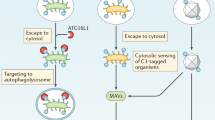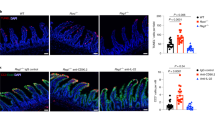Abstract
The complement system is widely regarded as essential for normal inflammation, not least because of its ability to activate mast cells1,2,3,4,5. However, recent studies have called into question the importance of complement in several examples of mast cell-dependent inflammatory responses6,7,8,9. To investigate the role of complement in mast cell-dependent natural immunity, we examined the responses of complement-deficient mice10,11 to caecal ligation and puncture12, a model of acute septic peritonitis12,13 that is dependent on mast cells and tumour necrosis factor-α (TNF-α). We found that C4- or C3-deficient mice10,11 were much more sensitive to caecal ligation and puncture than wild-type (WT) controls (100% versus 20% in 24-h mortality, respectively). C3-deficient mice also exhibited reductions in peritoneal mast cell degranulation, production of TNF-α, neutrophil infiltration and clearance of bacteria. Treating the C3-deficient mice with purified C3 protein enhanced activation of peritoneal mast cells, TNF-α production, neutrophil recruitment, opsonophagocytosis of bacteria and resistance to caecal ligation and puncture, confirming that the defects were complement-dependent. These results provide formal evidence that complement activation is essential for the full expression of innate immunity in this mast cell-dependent model of bacterial infection.
This is a preview of subscription content, access via your institution
Access options
Subscribe to this journal
Receive 51 print issues and online access
$199.00 per year
only $3.90 per issue
Buy this article
- Purchase on Springer Link
- Instant access to full article PDF
Prices may be subject to local taxes which are calculated during checkout




Similar content being viewed by others
References
Muller-Eberhard, H. J. Molecular organization and function of the complement system. Annu. Rev. Biochem. 57, 321–347 (1988).
Reid, K. B. M. & Porter, R. R. The proteolytic activation system of complement. Annu. Rev. Biochem. 50, 433–464 (1981).
Lepow, I. H., Wilms-Kretschmer, K., Patrick, R. A. & Rosen, F. S. Gross and ultrasctructural observations on lesions produced by intradermal injection of human C3a in man. Am. J. Pathol. 61, 13–23 (1970).
Dias Da Silva, W. & Lepow, I. H. Complement as a mediator of inflammation. II. Biological properties of anaphylatoxin prepared with purified components of human complement. J. Exp. Med. 125, 921–946 (1967).
Johnson, A. R., Hugli, T. E. & Muller-Eberhard, H. J. Release of histamine from rat mast cells by the complement peptides C3a and C5a. Immunology 28, 1067–1080 (1975).
Miyajima, I. et al. Systematic anaphylaxis in the mouse can be mediated largely through IgG1 and FcγRIII. Assessment of the cardiopulmonary changes, mast cell degranulation and death associated with active or IgG1-dependent passive anaphylaxis. J. Clin. Invest. 99, 901–914 (1997).
Sylvestre, D. L. & Ravetch, J. V. Fc receptors initiate the Arthus reaction: redefining the inflammatory cascade. Science 265, 1095–1098 (1994).
Hazenbos, W. L. W. et al. Impaired IgG-dependent anaphylaxis and arthus reaction in FcγRIII (CD16) deficient mice. Immunity 5, 181–188 (1996).
Sylvestre, D., Clynes, R., Ma, M., Carroll, M. C. & Ravetch, J. Immunoglobulin G-mediated inflammatory responses develop normally in complement-deficient mice. J. Exp. Med. 184, 2385–2392 (1996).
Fischer, M. B. et al. Regulation of the B cell response to T-dependent antigens by classical pathway complement. J. Immunol. 157, 549–556 (1996).
Wessels, M. R. et al. Studies of group B streptococcal infection in mice deficient in complement C3 or C4 demonstrate an essential role for complement in both innate and acquired immunity. Proc. Natl Acad. Sci. USA 12, 11490–11494 (1995).
Wichterman, K. A., Baue, A. E. & Chaudry, I. H. Sepsis and septic shock; a review of laboratory models and a proposal. J. Surg. Res. 29, 189–201 (1980).
Echtenacher, B., Männel, D. N. & Hültner, L. Critical protective role of mast cells in a model of acute septic peritonitis. Nature 381, 75–77 (1996).
Fischer, M. B. et al. Increased susceptibility to endotoxin shock in complement C3 and C4 deficient mice is corrected by C1 inhibitor replacement. J. Immunol. 159, 976–982 (1997).
Leal-Berumen, I., Conlon, P. & Marshall, J. S. Interleukin-6 production by rat peritoneal mast cels is not necessarily preceded by histamine release and can be induced by bacterial lipopolysaccharide. J. Immunol. 152, 5468–5476 (1994).
Gordon, J. R. & Galli, S. J. Mast cells are a source of both preformed and immunologically inducible TNF-α/cachectin. Nature 346, 274 (1990).
Gordon, J. R. & Galli, S. J. Release of both preformed and newly synthesized tumor nectrosis factor α(TNF-α)/cachectin by mouse mast cells stimulated by the FCεRI. A mechanism for the sustained action of mast cell-derived TNF-α during IgE-dependent biological responses. J. Exp. Med. 174, 103–107 (1991).
Malaviya, R., Ikeda, T., Ross, E. & Abraham, N. Mast cell modulation of neutrophil influx and bacterial clearance at sites of infection through TNF-α. Nature 381, 77–80 (1996).
Wershil, B. K., Wang, Z.-S., Gordon, J. R. & Galli, S. J. Recruitment of neutrophils during IgE-dependent cutaneous late phase responses in the mouse is mast cell-dependent: partial inhibition of the reaction with antiserum against tumor necrosis factor-alpha. J. Clin. Invest. 87, 446–453 (1991).
Zhang, Y., Ramos, B. F. & Jakschik, B. A. Augmentation of reverse passive arthus reaction by mast cells in mice. J. Clin. Invest. 88, 841–846 (1991).
Ramos, B. F., Zhang, Y. & Jakschik, B. A. Neutrophil elicitation in the reverse passive arthus reaction. J. Immunol. 152, 1380–1384 (1994).
Vassalli, P. The pathophysiology of tumor necrosis factor. Annu. Rev. Immunol. 10, 411–452 (1992).
Gerard, C. & Gerard, N. P. 5a anaphylatoxin and its seven transmembrane-segment receptor. Annu. Rev. Immunol. 12, 775–808 (1994).
Nilsson, U. R. & Muller-Eberhard, H. J. Deficiency of the fifth component of complement in mice with an inherited complement defect. J. Exp. Med. 125, 1–16 (1967).
Hopken, U. E., Lu, B., Gerard, N. P. & Gerard, C. The C5a chemoattractant receptor mediates defence to infection. Nature 383, 86–89 (1996).
Briles, D. et al. Antiphosphocholine antibodies found in normal mouse serum are protective against intravenous infection with type 3 Streptococcus pneumoniae. J. Exp. Med. 153, 694–705 (1981).
Reid, R. R. et al. Unraveling the role of natural antibody and complement in the clearance of lipopolysaccharide. J. Immunol. 159, 970–975 (1997).
Epstein, J., Eichbaum, Q. E., Sheriff, S. & Ezekowitz, R. A. B. The collectins in innate immunity. Curr. Opin. Immunol. 8, 29–35 (1996).
Vranian, G., Conrad, D. H. & Ruddy, S. Specificity of C3 receptors that mediate phagocytosis by rat peritoneal mast cells. J. Immunol. 126, 2302–2306 (1981).
Ahearn, J. et al. Disruption of the Cr2 locus results in a reduction in B-1a cells and in an impaired B cell response to T-dependent antigen. Immunity 4, 251–262 (1996).
Acknowledgements
We thank M. Ma, J. Xia and L. Fox for excellent technical assistance. This study was supported by grants from the National Institutes of Health and Cambridge Antibodies Technology, UK.
Author information
Authors and Affiliations
Corresponding author
Rights and permissions
About this article
Cite this article
Prodeus, A., Zhou, X., Maurer, M. et al. Impaired mast cell-dependent natural immunity in complement C3-deficient mice. Nature 390, 172–175 (1997). https://doi.org/10.1038/36586
Received:
Accepted:
Issue Date:
DOI: https://doi.org/10.1038/36586
This article is cited by
-
Targeting complement cascade: an alternative strategy for COVID-19
3 Biotech (2020)
-
Complement component C3a plays a critical role in endothelial activation and leukocyte recruitment into the brain
Journal of Neuroinflammation (2016)
-
Activation of C3a receptor is required in cigarette smoke-mediated emphysema
Mucosal Immunology (2015)
-
The role of mast cells in neuroinflammation
Acta Neuropathologica (2013)
Comments
By submitting a comment you agree to abide by our Terms and Community Guidelines. If you find something abusive or that does not comply with our terms or guidelines please flag it as inappropriate.



